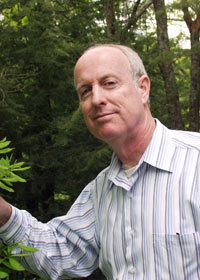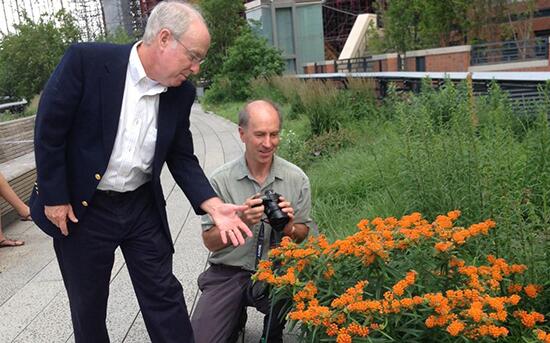Celebrating Native Plants: A Profile of Doug Tallamy
Posted in Horticulture on February 11 2015, by Sonia Uyterhoeven
Sonia Uyterhoeven is NYBG‘s Gardener for Public Education.

(Photo: Lisa Mattei)
I went to hear Doug Tallamy speak, recently. An entomologist and wildlife ecologist, his reputation first came about in 2007 when he published Bringing Nature Home.
In this seminal work on backyard wildlife ecology, Tallamy impressed on his readers the interdependency of plants, insects, butterflies, and birds. He made a call to arms asking gardeners to take on the challenge of becoming important players in the management of our nation’s wildlife by judiciously selecting local native plants for their gardens.
In 2014, Tallamy collaborated with gardening guru Rick Darke on another ecologically principled work entitled The Living Landscape. This book embodies what I hope will be an enduring trend in gardening. It is an upscale gardening book featuring gorgeous images that catapult you into another realm. Embedded in the gloss and glitter is informative, well-written content that educated and elucidates. The enduring trend which I am hopeful of is the celebration of the association between gardening and nature at large. It is a hope that the trend toward gardening with natives is imbued with a strong sense of stewardship and based on sound ecological principles.
But why is this sense of stewardship important? With close to 52% of open land taken over by agriculture and 43% devoted to suburban and urban sprawl, it is imperative that we garden with nature in mind if we’re to preserve biodiversity. Let’s illustrate this with an example given by Tallamy and Darke.
Since 1976, there has been a 90% decrease in the monarch butterfly population. I don’t need to tell you this; we have all seen the numbers of this once common butterfly plummet year by year. How has this happened?
There are several hypotheses. The oyamel or sacred fir (Abies religiosa) forests in Mexico, where monarchs overwinter, are being logged—they are disappearing. Milkweed has virtually been eliminated from agriculture land due to the use of Round-Up ready corn and soybean technology, thwarting the monarchs’ ability to reproduce as they fly north for the summer. Midwestern droughts in recent years have led to the decline of wildflower populations that support monarchs as they migrate south.

These factors are only compounded by sterile landscapes (large lawns, exotic introductions) that offer minimal food and shelter. How can we expect to maintain diversity? The good news is that it often takes very little to make a difference and help address the imbalance. Tallamy referred to an experiment in Delaware where they included common milkweed (Asclepias syriaca) in a naturalistic planting within a 15′ x 15′ plot. It produced 150 monarchs in one season.
Tallamy asks the public to use plants that support wildlife when designing their gardens, regardless of whether it is for an attractive pollinator like the monarch or a common grub that will feed a hungry bird. He advocates using native plants from your region, those that have evolved to support local food webs. Through his research, Tallamy demonstrates that “not all plants are created equal” when it comes to ecosystem services. Native plants provide food and shelter for insects and birds at a vastly higher ratio than non-natives.
While Tallamy presents an ecological dictum in Bringing Nature Home, he and Darke advocate landscapes that are “functional as well as beautiful” in The Living Landscape. In their treatise, the authors explore different habitat layers in the landscape and discuss how they can be implemented in the home garden. The book provides ecological strategies and inspiration for the home gardener. I recommend it as a good read!

